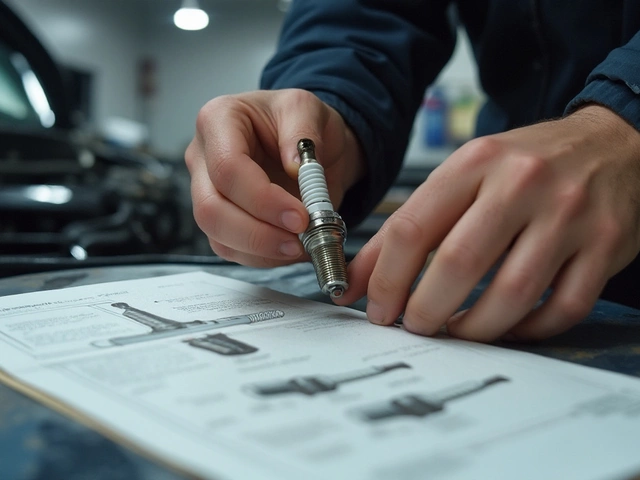If your car is sputtering on cold mornings, struggling to start, or suddenly losing power when you step on the gas, it’s not just bad luck. More than likely, your spark plugs are worn out. These small parts do the heavy lifting in your engine-igniting the fuel-air mix with a precise electric spark. When they fail, your whole engine feels it. And unlike some car problems, spark plug issues don’t sneak up quietly. They scream.
Your car is hard to start
If your engine turns over slowly or takes three or four tries before it catches, especially in cold weather, that’s a red flag. Spark plugs that are fouled, corroded, or worn out can’t produce a strong enough spark to ignite the fuel reliably. You might hear a clicking sound from the starter, but the engine just won’t fire. This isn’t a battery issue-if your battery is fine, and the lights come on bright, the problem’s in the ignition system. I’ve seen cars in Manchester garages where owners replaced the battery, then the starter, only to find out the spark plugs hadn’t been changed in 80,000 miles. That’s way past their limit.
Engine misfires and rough idle
Ever notice your car shaking when you’re stopped at a red light? Or the engine sounds like it’s hiccuping? That’s a misfire. One or more cylinders aren’t firing properly because the spark plug isn’t delivering a consistent spark. The result? Uneven combustion. You’ll feel it in the steering wheel, the pedals, even the seat. Misfires don’t just feel bad-they waste fuel, increase emissions, and can damage your catalytic converter over time. If your check engine light flashes instead of staying steady, that’s a serious misfire warning. Don’t ignore it. A flashing light means the engine is dumping raw fuel into the exhaust, which can melt the converter. Replacing spark plugs is cheap. Replacing a catalytic converter? Not so much.
Poor fuel economy
Gas prices are still high. If you’ve noticed you’re filling up more often than usual and you haven’t changed your driving habits, spark plugs could be to blame. Worn plugs burn fuel inefficiently. Instead of a clean, complete burn, you get partial combustion-meaning some fuel just escapes out the exhaust without doing any work. I’ve tested cars with old spark plugs that saw a 15-20% drop in MPG. One customer in Salford was getting 28 mpg on his Honda Civic. After replacing the plugs, he jumped to 34 mpg. That’s £30 a month saved on fuel alone. Spark plugs are a low-cost fix with a fast payback.
Sluggish acceleration
When you press the accelerator and the car hesitates before responding, that’s not just a lazy throttle. It’s the engine struggling to ignite fuel quickly enough. Bad spark plugs cause delayed ignition timing. The spark comes too late or too weak, so the power stroke doesn’t happen when it should. The result? You feel like you’re driving through syrup. On the motorway, merging into traffic becomes a gamble. On hills, the car loses steam. This isn’t just annoying-it’s unsafe. If your car feels like it’s running on three cylinders instead of four or six, you’re not just losing performance. You’re risking a breakdown.

Check engine light is on
Modern cars are packed with sensors. If your spark plugs are failing, the oxygen sensor will pick up unburned fuel in the exhaust. The engine control unit will throw a code-usually P0300 (random misfire) or P0301 through P0306 (misfire in specific cylinders). That’s your car saying, “Something’s wrong with ignition.” Don’t just clear the code and forget it. The problem won’t go away. A code like P0302 means cylinder two isn’t firing. That’s almost always a bad spark plug in that cylinder. Even if the light goes off later, the damage is still happening. Spark plugs wear out gradually. The check engine light is your last warning before things get expensive.
Visual signs-remove and check them
The best way to know for sure? Take them out. You don’t need a garage. A socket wrench, a spark plug gap tool, and 20 minutes are all you need. Look for these telltale signs:
- Black, sooty deposits-this means the air-fuel mix is too rich, or the plug is running too cold. Common in short-trip driving.
- White or blistered electrodes-sign of overheating. Could be wrong plug heat range, or engine running too lean.
- Oil residue-if oil is coating the plug, you’ve got a valve seal or piston ring leak. Plugs won’t fix this, but replacing them won’t hurt while you diagnose.
- Worn or eroded electrodes-the gap between the center and side electrode is too wide. New plugs have a gap of 0.6-1.1mm. If it’s over 1.5mm, it’s time to replace.
- Cracked porcelain-any visible cracks mean the plug is done. Even a tiny crack can cause misfires.
Most modern spark plugs last between 60,000 and 100,000 miles, depending on type. Copper plugs wear out faster-around 20,000 to 30,000 miles. Platinum and iridium last longer. But mileage isn’t the only factor. If you drive mostly short trips in the city, your plugs gunk up faster. Cold starts, stop-and-go traffic, and idling in traffic all accelerate wear. A car that’s been sitting for months? Moisture builds up. Corrosion sets in.
When to replace them-don’t wait for failure
Manufacturers list spark plug replacement intervals in your owner’s manual. But that’s a guideline, not a rule. If you drive in stop-and-go traffic, in damp climates like Manchester, or you use lower-quality fuel, replace them sooner. I recommend checking them every 30,000 miles, even if the manual says 60,000. If your car is over 10 years old and you don’t know when they were last changed, assume they’re worn. Replacing spark plugs is one of the easiest and cheapest maintenance tasks you can do. Labor costs range from £50 to £100 in the UK. Parts? £20 to £60 for a full set. That’s less than a tank of fuel. And if you do it yourself? You save the labor and learn something useful.

What happens if you don’t change them
Ignoring bad spark plugs doesn’t just mean a rough ride. It leads to bigger, costlier problems:
- Catalytic converter damage-unburned fuel overheats and melts the internal honeycomb structure. Replacement cost: £800-£1,500.
- Engine damage-prolonged misfires can cause piston damage or bent valves in interference engines.
- Failed MOT-excessive emissions from misfires will cause your car to fail its annual test.
- Stranded on the side of the road-a completely failed plug can leave you stuck with a car that won’t start.
There’s no benefit to waiting. Spark plugs don’t get better with age. They get worse. And the longer you wait, the more damage you risk.
What to look for when buying new ones
Not all spark plugs are the same. Your car needs the right type:
- Copper-cheapest, good for older cars, but shortest lifespan.
- Platinum-lasts longer, better for fuel efficiency, common in mid-2000s to 2010s cars.
- Iridium-best performance, longest life (up to 120,000 miles), ideal for modern engines.
Check your owner’s manual or look up your exact model and engine. Using the wrong heat range or thread size can cause serious problems. Don’t buy the cheapest pack you find. Stick to trusted brands like NGK, Denso, Bosch, or Champion. They’re made to exact OEM specs. Aftermarket plugs might save you a few pounds, but they can cause misfires, poor idle, or even engine damage.
Final tip: Keep a record
Once you replace your spark plugs, write down the date and mileage. Stick it on the inside of your fuel flap or in your service book. That way, you’ll know exactly when to check them again. No more guessing. No more surprises. A simple note saves you time, money, and stress.
How often should I change my spark plugs?
Most modern spark plugs last between 60,000 and 100,000 miles, depending on the material. Copper plugs need replacing every 20,000-30,000 miles. Platinum and iridium last longer. But if you drive mostly short trips, in cold or damp conditions, or use low-quality fuel, replace them every 30,000 miles. Always check your owner’s manual for the manufacturer’s recommendation.
Can bad spark plugs cause my car to fail an MOT?
Yes. If your spark plugs are worn and causing misfires, your engine will emit higher levels of unburned hydrocarbons and carbon monoxide. This triggers a failure during the emissions test portion of the MOT. Even if the car runs fine, a faulty ignition system can cause a fail. Many MOT failures in the UK are linked to ignition issues, not just exhaust problems.
Is it safe to drive with a bad spark plug?
You can drive short distances, but it’s not safe or smart. A single bad plug can cause misfires, poor acceleration, and increased emissions. Over time, it can damage your catalytic converter or even the engine itself. If you notice shaking, rough idling, or the check engine light flashing, get it fixed immediately. Don’t risk a breakdown on a busy road.
Can I replace spark plugs myself?
Yes, most people can. You’ll need a spark plug socket, a torque wrench (recommended), and a gap tool. Make sure the engine is cold before you start. Remove the ignition coils or leads one at a time. Don’t mix up the order. Clean the area around the plug before removing it to avoid debris falling into the cylinder. Tighten new plugs to the torque spec in your manual-over-tightening can crack the threads.
Do I need to replace all spark plugs at once?
Always. Even if only one is bad, the others are likely close to failure. Replacing them all ensures even performance across all cylinders. Mixing old and new plugs can cause imbalance in ignition timing, leading to more misfires. It’s cheaper and smarter to do them all at once.


